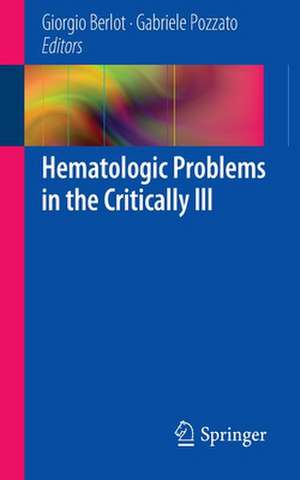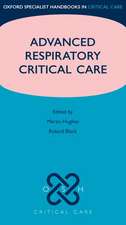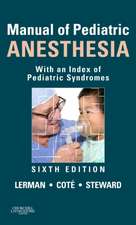Hematologic Problems in the Critically Ill
Editat de Giorgio Berlot, Gabriele Pozzatoen Limba Engleză Paperback – 28 oct 2014
The scenarios considered include critical illness in patients with anemia, leukopenia, leukocytosis, abnormal platelet count, and severe transfusion reactions. For each circumstance, factors relevant to symptom interpretation are fully discussed. In addition, helpfuldiagnostic algorithms are presented in the form of flow charts that will assist in decision making regarding the need for further investigations. The closing chapter is devoted to the drug-induced hematologic disorders. Although the book is intended mainly for intensivists, other specialists will find much information of value for their daily practice.
Preț: 701.93 lei
Preț vechi: 738.86 lei
-5% Nou
Puncte Express: 1053
Preț estimativ în valută:
134.42€ • 137.17$ • 113.10£
134.42€ • 137.17$ • 113.10£
Carte tipărită la comandă
Livrare economică 25 februarie-11 martie
Preluare comenzi: 021 569.72.76
Specificații
ISBN-13: 9788847053007
ISBN-10: 8847053005
Pagini: 250
Ilustrații: V, 147 p. 3 illus. in color.
Dimensiuni: 127 x 203 x 12 mm
Greutate: 0.2 kg
Ediția:2015
Editura: Springer
Colecția Springer
Locul publicării:Milano, Italy
ISBN-10: 8847053005
Pagini: 250
Ilustrații: V, 147 p. 3 illus. in color.
Dimensiuni: 127 x 203 x 12 mm
Greutate: 0.2 kg
Ediția:2015
Editura: Springer
Colecția Springer
Locul publicării:Milano, Italy
Public țintă
Professional/practitionerCuprins
Introduction.- Anemia.- Anemia in the Critically Ill Patients.- Leukopenia in the Critically Ill Patients.- Leukocytosis in the Critically Ill Patients.- The critically ill patient with abnormal platelet count.- Transfusion adverse reactions in critically ill patients.- Drugs and blood cells.
Recenzii
From the book reviews:
“This is a pocket guide to common hematologic disorders occurring in patients in the hospital, particularly in the critical care unit. … Students and practitioners of critical care are an appropriate audience for this book … . a quick read and valuable pocket guide for a set of problems that appear in patients in any critical care unit. I recommend this for seasoned providers requiring a quick reference and to junior practitioners needing an introduction to this group of problems.” (David J. Dries, Doody's Book Reviews, December, 2014)
“This is a pocket guide to common hematologic disorders occurring in patients in the hospital, particularly in the critical care unit. … Students and practitioners of critical care are an appropriate audience for this book … . a quick read and valuable pocket guide for a set of problems that appear in patients in any critical care unit. I recommend this for seasoned providers requiring a quick reference and to junior practitioners needing an introduction to this group of problems.” (David J. Dries, Doody's Book Reviews, December, 2014)
Textul de pe ultima copertă
This book covers a wide array of hematologic problems commonly encountered in the daily practice of critical care and emergency medicine. Unfortunately, the symptoms and signs associated with underlying hematologic disorders are frequently rather unspecific and confounding; furthermore, the clinical course of patients admitted to intensive care units with such disorders can be fulminant, warranting prompt diagnosis. This book recognizes the importance of accurate and speedy interpretation of symptoms in that the text is symptom oriented rather than disease oriented. Put another way, the reader confronted with a particular clinical problem or symptom will be guided step by step to the possible underlying disorder(s).
The scenarios considered include critical illness in patients with anemia, leukopenia, leukocytosis, abnormal platelet count, and severe transfusion reactions. For each circumstance, factors relevant to symptom interpretation are fully discussed. In addition, helpfuldiagnostic algorithms are presented in the form of flow charts that will assist in decision making regarding the need for further investigations. The closing chapter is devoted to the drug-induced hematologic disorders. Although the book is intended mainly for intensivists, other specialists will find much information of value for their daily practice.
The scenarios considered include critical illness in patients with anemia, leukopenia, leukocytosis, abnormal platelet count, and severe transfusion reactions. For each circumstance, factors relevant to symptom interpretation are fully discussed. In addition, helpfuldiagnostic algorithms are presented in the form of flow charts that will assist in decision making regarding the need for further investigations. The closing chapter is devoted to the drug-induced hematologic disorders. Although the book is intended mainly for intensivists, other specialists will find much information of value for their daily practice.
Caracteristici
Symptom-oriented approach to diagnosis of hematologic problems in critically ill patients Covers a wide range of scenarios commonly encountered in intensive care units Includes helpful flow charts to assist in diagnosis and decision making?







